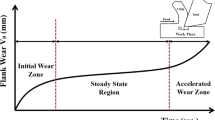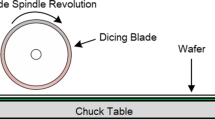Abstract
The present describes the research work involved in prediction of life of compound die using Artificial Neural Network (ANN). The parameters affecting the life of compound die are investigated through Finite Element Analysis (FEA) and the critical simulation values are determined. Based on FEA results, S–N approach is used for calculation of number of cycles of compound die. The number of cycles gives the number of sheet metal parts that can be produced on compound die before its failure. The proposed ANN model is tested successfully on different compound dies designed for manufacturing various industrial sheet metal parts.
Access this chapter
Tax calculation will be finalised at checkout
Purchases are for personal use only
Similar content being viewed by others
References
Aguir H, Alves JL, Oliveira MC, Menezes LF, BelhadjSalah H, Hambli R (2009) Identification of anisotropic parameters using the cylindrical cup deep drawing test and the coupled ANN-inverse method. In: 7th EUROMECH solid mechanics conference, pp 1–11
Bozdemir M, Golcu M (2008) Artificial neural network analysis of springback in V bending. J Appl Sci 8(17):3038–3043
Campbell FC (2013) Metals fabrication: understanding the basics. ASM Int, USA
Cheng PJ, Lin SC (2000) Using neural networks to predict bending angle of sheet metal formed by laser. Int J of Mach Tools Manuf 40:1185–1197
Choi HS, Kim BM, Nam KJ, Cha SH, Kang CG (2011) Development of hot stamped center pillar using form die with channel type indirect blank holder. Int J of Auto Technol 12(6):887–894
Deng Z, Zhang Y (2010) The precise prediction of springback based on GRN. In: International conference on artificial intelligence and computational intelligence, IEEE, pp 290–293
Djavanroodi F, Pirgholi A, Derakhshani E (2010) FEM and ANN analysis in fine-blanking process. Mater Manuf Processes 25:864–872
Drugos V, Dun V, Kovucevic R (2000) Prediction of the laser sheet bending using neural network. In: IEEE international symposium on circuits and systems, Geneva, pp 686–689
Du Y, Wang X, Silvanus J (2010) Improved BP network to predict bending angle in the laser bending process for sheet metal. In: International conference on intelligent system design and engineering application, IEEE computer society, pp 839–843
Forcellese A, Gabrielli F, Ruffini R (1998) Effect of the training set size on springback control by neural network in an air bending process. J of Mater Process Technol 80–81:493–500
Frayman Y, Rolfe BF, Webb GI (2002) Improving an inverse model of sheet metal forming by neural network based regression. In: The 2002 ASME computers and information in engineering conference, pp 1–8
Fu Z, Mo J, Chen L, Chen W (2010) Using genetic algorithm-back propagation neural network prediction and finite-element model simulation to optimize the process of multiple-step incremental air-bending forming of sheet metal. Mater Des 31:267–277
Geiger M, Knoblach J, Backes F (1998) Cost estimation for large scale production of sheet metal parts using artificial neural networks. University of Erlangen-Nuremberg, institute for manufacturing science. Prod Eng 2:81–84
Gisario A, Barletta M, Conti C, Guarino S (2011) Springback control in sheet metal bending by laser-assisted bending: Experimental analysis, empirical and neural network modeling. Opt Lasers Eng 49:1372–1383
Graham JA (1968) Fatigue design handbook. SAE, USA
Hambli R (2002) Prediction of burr height formation in blanking processes using neural network. Int J Mech Sci 44:2089–2102
Hambli R (2005) Optimization of blanking processes using neural network simulation. Arabian J Sci Eng 30:3–16
Hambli R, Guerin F (2003) Application of a neural network for optimum clearance prediction in sheet metal blanking processes. Finite Elem Anal Des 39:1039–1052
Hanazono M, Nishimura H, Harada H, Marumo Y, Yamaguchi T (2010) Slide-bending formation of metallic sheet using neural network. In: International conference on control, automation and systems, IEEE, pp 34–37
Hussaini SM, Singh SK, Gupta AK (2014) Experimental and numerical investigation of formability foraustenitic stainless steel 316 at elevated temperatures. J Mater Res Technol 3(1):17–24
Inamdar MV, Date PP, Desai UB (2000a) Studies on the prediction of springback in air vee bending of metallic sheets using an artificial neural network. J Mater Process Technol 108:45–54
Inamdar MV, Date PP, Narasimhan K, Maiti SK, Singh UP (2000b) Development of an artificial neural network to predict springback in Air Vee Bending. Int J Adv Manuf Technol 16:376–381
Ivezic N, Allen JD, Zacharia T (1999) Neural network method for in modeling of material deformation. In: Proceeding 2nd international conference on intelligent processing and manufacturing of materials, pp 961–966
Kashid S, Kumar S (2012) Applications of artificial neural network to sheet metal work - A Review. Am J Intell Syst 2(7):168–176
Kashid S, Kumar S (2014a) Prediction of life of compound die using artificial neural network. Key Eng Mater 622–623:664–671
Kashid S, Kumar S (2014b) Prediction of life of die block using artificial neural network. Appl Mech Mater 592–594:689–693
Kashid S, Kumar S, Hussein HMA (2015) Selection, modeling and prediction of life of stripper of compound die. Key Eng Mater 639:501–508
Kazan R, Fırat M, Tiryaki AE (2009) Prediction of springback in wipe-bending process of sheet metal using neural network. Mater Des 30:418–423
Kazymyrovych V (2010) Very high cycle fatigue of tool steels. Faculty of technology and science materials engineering, Karlstad University Studies, Karlstad, Sweden
Kim DJ, Kim BM (2000) Application of neural network and FEM for metal forming processes. Int J Mach Tools Manuf 40:911–925
Klingenberg B, Boer TW (2008) Condition-based maintenance in punching/blanking of sheet metal. Int J Mach Tools Manuf 48:589–598
Kriesel D (2007) A brief introduction to neural networks. Zeta vision. http://www.dkriesel.com
Kumar S, Singh R (2007) A short note on an intelligent system for selection of materials for progressive die components. J Mater Process Technol 182:456–461
Kurtaran H (2008) A novel approach for the prediction of bend allowance in air bending and comparison with other methods. Int J Adv Manuf Technol 37:486–495
Li Q, Li M, Li Q, Tian Y (2010) Optimization technology of sheet metal deep drawing with variable blank holder force. In: International conference on computer mechatronics, control and electronic engineering (CMCE), IEEE, pp 495–497
Lin ZC, Chang DY (1995) Application of a neural network machine learning model in the selection system of sheet metal bending tooling. Artif Intell Eng 10:21–37
Lin ZC, Chang H (1996) Application of fuzzy set theory and back propagation neural networks in progressive die design. J of Manuf System 15(4):268–281
Liu G, Yi Z (2010) Calculation method study on spring back of automobile ceiling. In: Computer engineering and technology (ICCET), vol 3, 2nd international conference, IEEE, pp 655–658
Liu N, Yang H, Li1 H, Yan S, Zhang H, Tang W (2015) BP artificial neural network modeling for accurate radius prediction and application in incremental in-plane bending. Int J Adv Manuf Technol 80:971–984
Liu W, Liu Q, Ruana F, Liang Z, Qiu H (2007) Springback prediction for sheet metal forming based on GA-ANN technology. J Mater Process Technol 187–188:227–231
Luo YJ, Zhang YQ, He DN (2003) Determination of blank holder force in sheet metal deep drawing process. Acta Metall Sin (English letters) 16(1):31–34
Manabe K, Yang M, Yoshihara S (1998) Artificial intelligence identification of process parameters and adaptive control system for deep-drawing process. J Mater Proc Technol 80–81:421–426
Nasrollahi V, Arezoo B (2012) Prediction of springback in sheet metal parts with holes on the bending area, using experiments, finite element and neural networks. Mater Des 36:331–336
Pathak KK, Anand VK, Agnihotri G (2008) Prediction of Geometrical Instabilities in Deep Drawing in Artificial Neural Network. J Eng Appl Sci 3(4):344–349
Pathak KK, Panthi S, Ramakrishnan N (2005) Application of neural network in sheet metal bending process. Defence Sci J 55:125–131
Ren S, Lai Y, Wu G, Gu J, Dai Y (2011) Intelligent prediction of process parameters for bending forming. Open Mech Eng J 5:26–31
Roy R (1996) Assessment of sheet-metal bending requirements using neural networks. Neural Comput Appl 4:35–43
Ruan F, Feng Y, Liu W (2008) Springback prediction for complex sheet metal forming parts based on genetic neural network. IEEE 1:157–161
Ruffini R, Cao J (1998) Using neural network for springback minimization in a channel forming process. J Mater Manufact 107(5):65–73
Singh D, Yousefi R, Boroushaki M (2011) Identification of optimum parameters of deep drawing of a cylindrical workpiece using neural network and genetic algorithm. World Acad Sci, Eng Technol 78:211–217
Singh SK, Kumar DR (2005) Application of a neural network to predict thickness strains and finite element simulation of hydro-mechanical deep drawing. Int J Adv Manuf Technol 25:101–107
Sivasankaran S, Narayanasamy R, Jeyapaul R, Loganathan C (2009) Modeling of wrinkling in deep drawing of different grades of annealed commercially pure aluminum sheets when drawn through a conical die using artificial neural network. Mater Des 30:3193–3205
Slomp J, Klingenberg W (2004) A proposal to use artificial neural networks for process control of punching/blanking operations. In: Flexible automation and intelligent manufacturing, FAIM2004 Toronto, Canada, pp 556–562
Tabatabaei M, Sulaiman A, Nikbakht A, Yusof N, Najafpour G (2011) Influential paramaters on biomethane generation in anaerobic water waste treatment plants. Alternaive Fuel, Chapter 10. doi:10.5772/24681
Verlinden B, Duflou JR, Collin P, Cattrysse D (2008) Cost estimation for sheet metal parts using multiple regression and artificial neural networks: A case study. Int J Prod Econ 111:484–492
Wadi I, Balendra R (1999) Using neural networks to model the blanking process. J Mater Process Technol 91:52–65
Wang J, Wu X, Thomson PF, Flitman A (2000) A neural networks approach to investigating the geometrical influence on wrinkling in sheet metal forming. J Mater Process Technol 105:215–220
Wu X, Wang J, Flitman A, Thomson P (1999) Neural and machine learning to the surface defect investigation in sheet metal forming. In: 6th international conference on neural information processing proceedings, Perth Australia, Nov 16–20, IEEE, Inc., New Jersey USA, pp 1088–1093
Zhang Y (2011) Optimization of blank holder force based on CAE and neural network. In: International conference on electronic & mechanical engineering and information technology, IEEE, pp 2896–2899
Zhao J, Wang F (2005) Parameter identification by neural network for intelligent deep drawing of axisymmetric workpiece. J Mater Process Technol 166:387–391
Author information
Authors and Affiliations
Corresponding author
Editor information
Editors and Affiliations
Rights and permissions
Copyright information
© 2017 Springer Science+Business Media Singapore
About this chapter
Cite this chapter
Salunkhe, S., Kumar, S., Hussein, H.M.A. (2017). Prediction of Life of Compound Die Using Artificial Neural Network. In: Kumar, S., Hussein, H. (eds) AI Applications in Sheet Metal Forming. Topics in Mining, Metallurgy and Materials Engineering. Springer, Singapore. https://doi.org/10.1007/978-981-10-2251-7_9
Download citation
DOI: https://doi.org/10.1007/978-981-10-2251-7_9
Published:
Publisher Name: Springer, Singapore
Print ISBN: 978-981-10-2250-0
Online ISBN: 978-981-10-2251-7
eBook Packages: EngineeringEngineering (R0)




